
In 15 starts for the Chargers, Justin Herbert established himself not just as one of the best rookie quarterbacks that we’ve seen, but as one of the best quarterbacks in the NFL full stop. He threw for the most ever touchdowns for a rookie and had the lowest interceptable pass rate in the NFL. Herbert showed impressive touch, accuracy, and anticipation. However, he also had some issues with pre-determining his throws, drifting into pressure in the pocket, and reading away from the designed concepts. Despite the issues on the offensive line and uninspiring play design, Herbert showed that he is the future for the Chargers.
Read More: New Chargers HC Brandon Staley Had the Rams Defense Playing at a Championship Level
Anticipation
In year one with the Chargers, Justin Herbert did something that a lot of NFL quarterbacks don’t do in their entire careers – he threw with anticipation. Anticipation throws are huge for young quarterbacks and allow for quicker reads and more tight-window throws. When you combine that anticipation with Herbert’s ball placement, there are some throws that he makes that are just impossible to defend.
The Chargers are running a simple 10-yard curl here against a Cover 1 blitz. Herbert knows he needs to get the ball out quickly and starts his throwing motion to throw the curl before the receiver is out of his break. That chemistry and trust is hard to build and is pretty special to see so quickly.
Herbert could also read and throw to green grass before his receiver entered the area. The Chargers are running the Y-Cross concept here. Y-Cross has one receiver running a cross route at 18-22 yards with the aim to catch the ball between the hashes and the numbers. That route is designed to force defenses to transfer zones or run with that player in coverage. To that side, there’s also someone in the flats to pull linebackers up and open up the window to the cross.
Learn more: Coaching Concepts
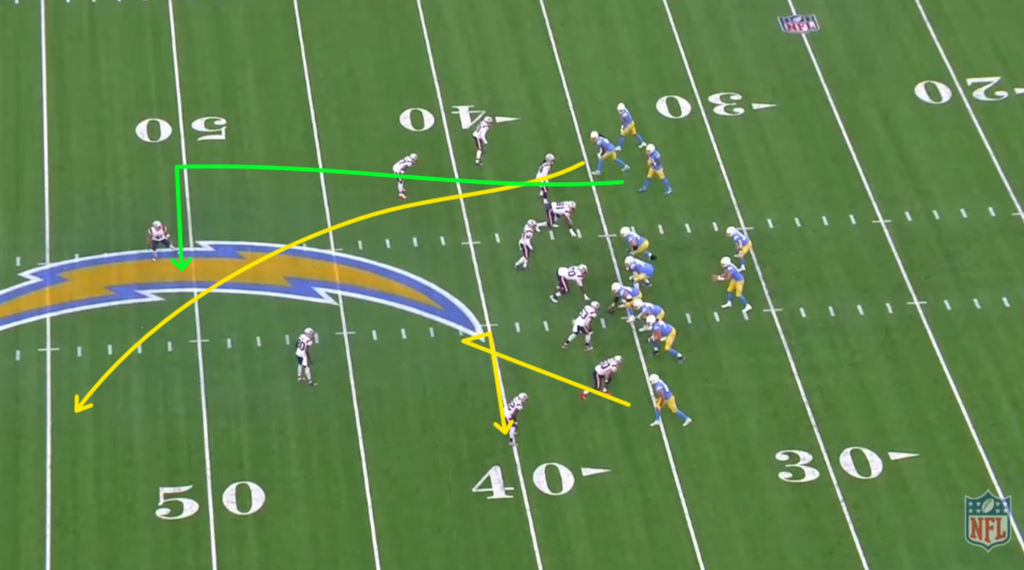
However, in this case, the Patriots are in Cover 3 Buzz. That allows the safety to buzz down and pick up the flat route and leaves the corner free to get depth to cover his deep third of the field. That, combined with the defender over the cross takes away the route. Behind that, is a deep dig. When the cross is taken away, that vacates the middle of the field. That’s when the dig route is thrown.
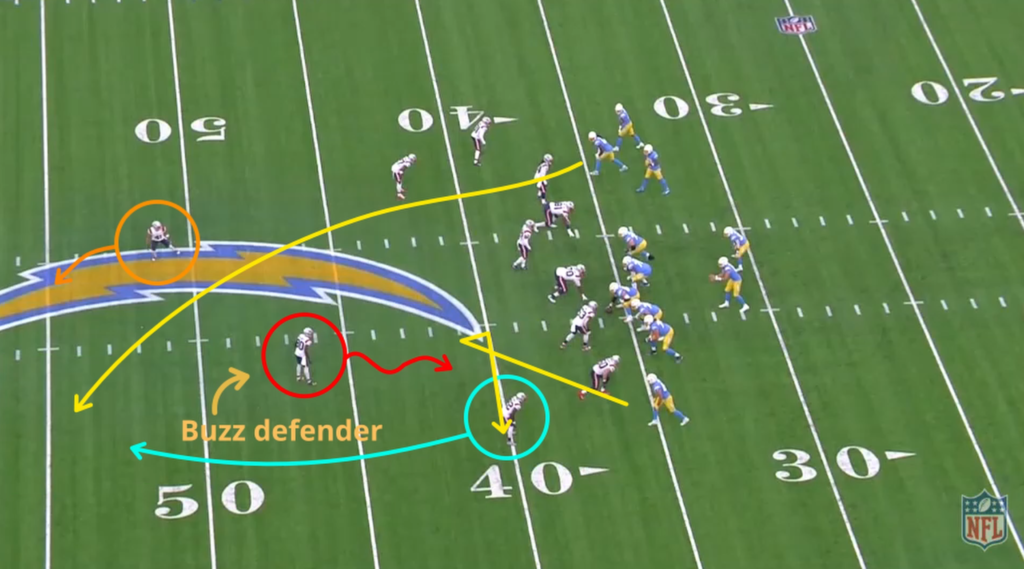
Herbert quickly diagnoses that Cover 3 buzz, understands that the cross route is taken away. He climbs the pocket and as his receiver is breaking on the dig, he begins his throwing motion to target the vacated space in front of him for a gain of 24 yards.
Eye Discipline
He has also shown some very good eye discipline. Here on a Hoss concept, with two seams from the inside receivers and curls on the outside, Herbert does a great job of holding the safety in the middle of the field before rifling the ball into the window between him and the trailing defender.
Even in the short game, Herbert shows the ability to move defenders with his eyes and look players off. The Chargers are running a spot flat concept with the receiver hooking up inside of the flowing flat defender. Aside from the defender navigating over the top to cover the spot, the player that can most impact that throw is the middle linebacker. Herbert looks directly at him to hold him in place. This creates a window to throw the spot route before he can make a play on the ball.
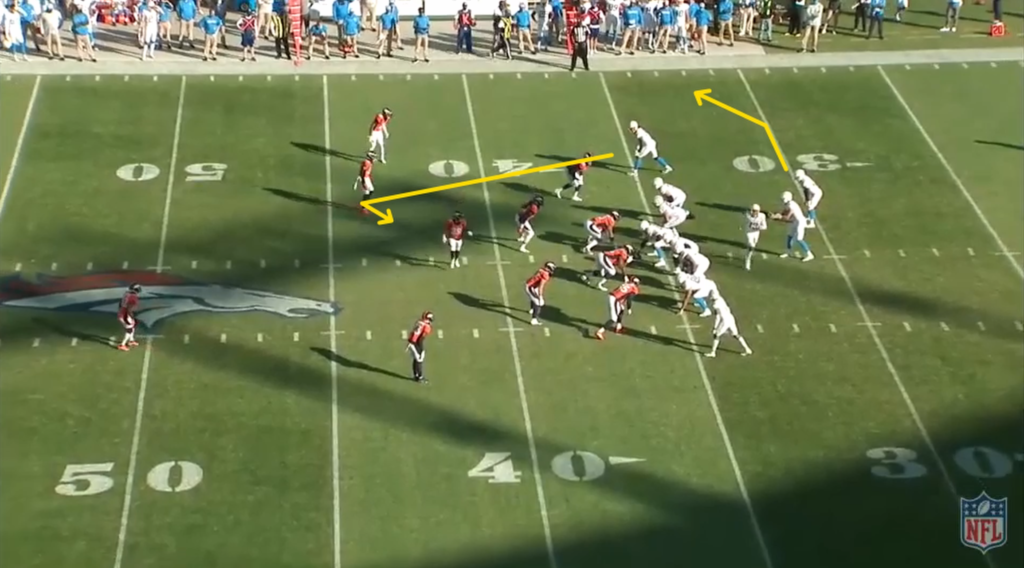
Raw Talent
These little things, when combined with Herbert’s raw talent, created an impressive first year. Some of the arm angles he made throws from were really special. You combine the talent with the ability to anticipate and you’ve got a quarterback that can completely transform the landscape of your franchise.
The talent is clearly there. Herbert showed that he has a very high ceiling, but he did have some issues reading away from designed concepts.
Incorrect Reads
On this play, Justin Herbert and the Chargers are running a variation on the Mills concept. That utilizes a dig and post behind it with a flat route underneath. The play is designed to attack both the linebackers and the deep defenders behind them. The flat route pulls defenders away from the dig and the dig can pull defenders away from the post.
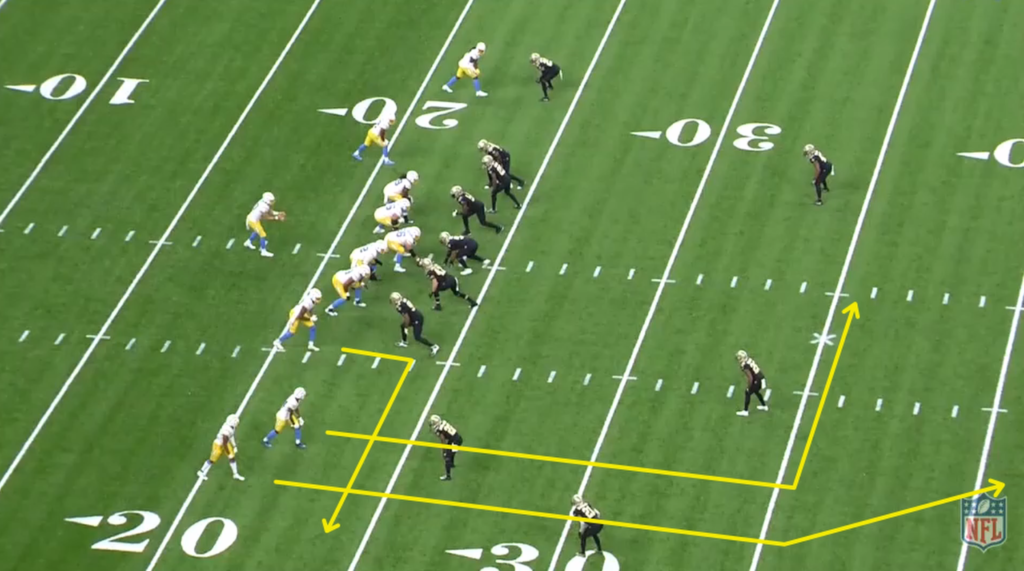
Both of those things happen here and that’s where the play is designed to be read. The linebacker is pulled up on the flat route which opens up the middle of the field. The safety has flipped his hips to cover what he thinks is a vertical route. He is now out of position to cover both the post and the dig.
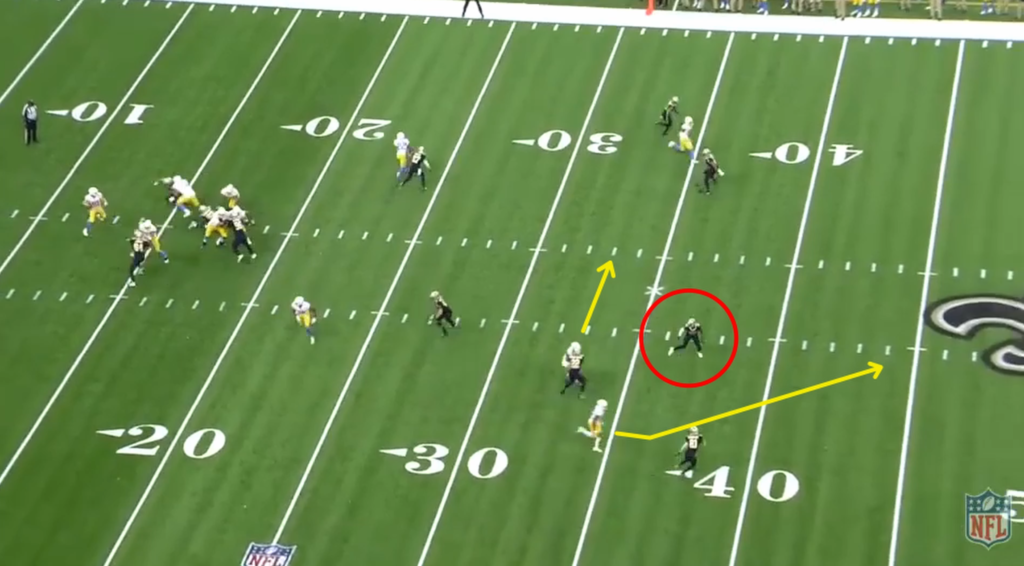
While there is pressure on this play, we just saw Herbert show he is capable of throwing with anticipation. The problem is, he’s not even looking at that side of the field. Instead, he’s reading the top of the screen with a deep out and flat route. However, the receiver immediately loses leverage with an inside release and his route is dead in the water. There’s nowhere to go with the ball, the pressure gets home, and it’s an incompletion.
These kind of mental lapses happened continually through the season. He showed great decision making and reads one play, then would look to the wrong side of the concept the very next. The Chargers are running a classic man-beater here with Mesh. It’s designed to create rubs and picks to spring players open coming shallow across the field. The Chargers even run a pre-snap motion to help Justin Herbert diagnose that it’s man coverage. The defender runs with the receiver, which indicates that it’s man. Instead of reading that Mesh concept and throwing to Hunter Henry, Herbert throws a contested ball that goes incomplete.
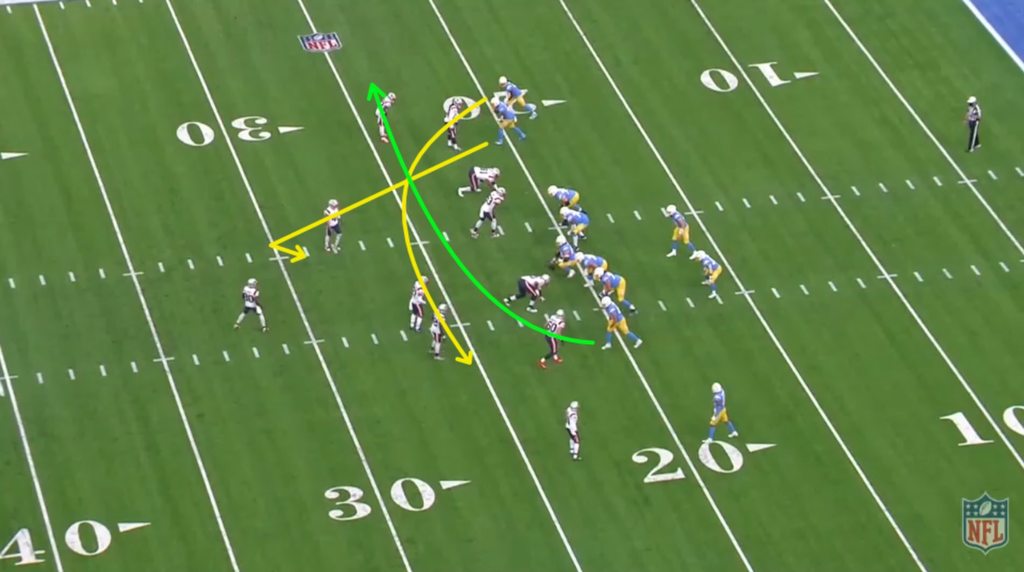
Mechanics
Herbert has consistently good mechanics. Those mechanics all stem from his base. That base should be slightly wider than shoulder width apart. That allows him to be able to fully rotate his hips into the throw. Hip rotation helps him generate accuracy and velocity.
Unsurprisingly, when he loses the ability to rotate his hips and instead gets his hips parallel to the line of scrimmage, he also loses his accuracy. That’s when you most often see him misplace balls.
Especially when he was facing the Patriots, who were getting after him up front with a lot of pressure, he started to drift away from throws and open his leg and toe towards the sideline. That prevents him from closing his shoulder to the throw and generating power from his feet up to his hips.
Dropback Issues
Adding onto some of those issues, was the way that the Chargers had him take drops. Part of that is on Herbert and part of that is on the coaching staff for LA. That staff is obviously is no longer there with Brandon Staley now in town. Out of shotgun, Herbert frequently took 5-step drops, which is asking a lot of your offensive line. Since you’re already five yards from the line of scrimmage, a 5-step drop puts Herbert at about 10 yards deep. That makes the angle much easier for pass rushers to get home. While his line did him no favors, compounding that with taking deep drops in shotgun wasn’t good game planning by the coaching staff. On Herbert’s end, he didn’t understand thatt he needed to climb more quickly on those drops.
Here, the line of scrimmage is on the 15-yard line. Herbert is dropping all the way back to the four. The tackle does get beat, but he’s expecting to be able to wash the edge rusher behind the pocket where Herbert will be safe and be able to climb. Since Herbert is so far back, it results in a sack. 5-step drops in shotgun are not super common and yet the Chargers routinely called them for Herbert.
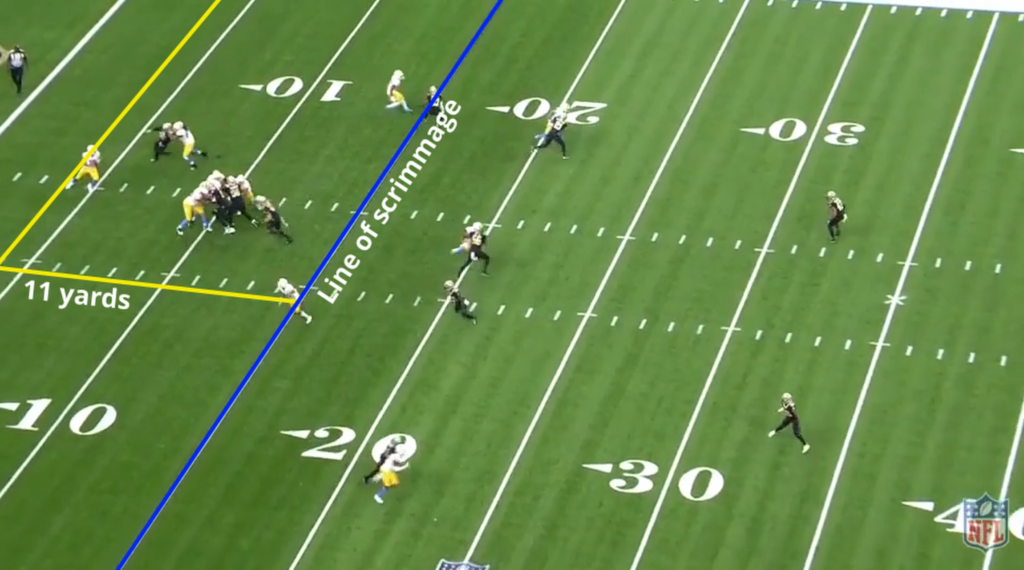
Combined with those deep drops, Herbert would also sometimes drift in the pocket. That would bring him into additional pressure. These are both easy to fix and will change in a new offensive system with Joe Lombardi as the offensive coordinator, but it made life harder on an already struggling offensive line.
Final Thoughts
Herbert has all the tools to help the Chargers win right now. Brandon Staley is a great defensive mind who should help a very talented defense live up to it’s potential. As Justin Herbert settles into a new offensive system and starts to attack concepts correctly, fine tune is drops and pocket movement, and uses those glimpses of anticipation and ball placement, the Chargers could very quickly start making noise in the AFC. Herbert raised the bar and eliminated a lot of the inconsistencies he had in college. He made some fantastic throws, showed complete control of the team, gave the offense life, and is the clear future for LA.
